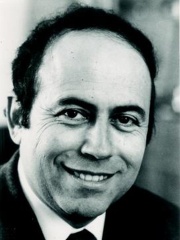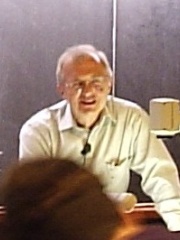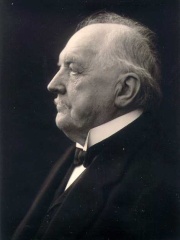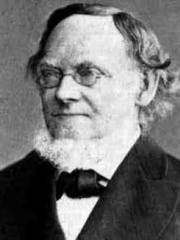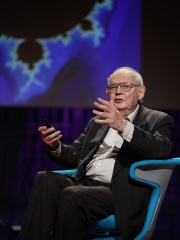

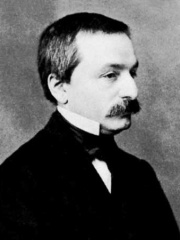
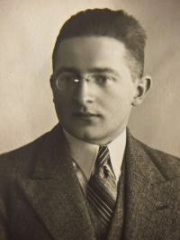
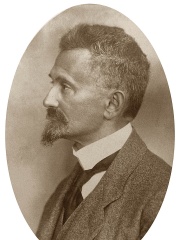
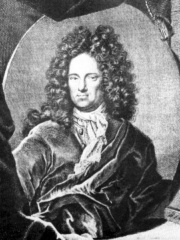
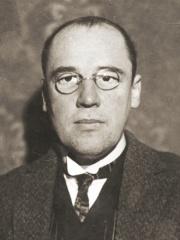
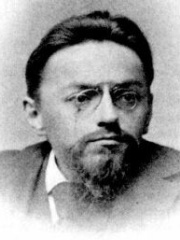
The Most Famous
MATHEMATICIANS from Poland
This page contains a list of the greatest Polish Mathematicians. The pantheon dataset contains 1,004 Mathematicians, 45 of which were born in Poland. This makes Poland the birth place of the 7th most number of Mathematicians behind Russia, and Italy.
Top 10
The following people are considered by Pantheon to be the top 10 most legendary Polish Mathematicians of all time. This list of famous Polish Mathematicians is sorted by HPI (Historical Popularity Index), a metric that aggregates information on a biography's online popularity. Visit the rankings page to view the entire list of Polish Mathematicians.

1. Benoit Mandelbrot (1924 - 2010)
With an HPI of 73.71, Benoit Mandelbrot is the most famous Polish Mathematician. His biography has been translated into 67 different languages on wikipedia.
Benoit B. Mandelbrot (20 November 1924 – 14 October 2010) was a Polish-born French-American mathematician and polymath with broad interests in the practical sciences, especially regarding what he labeled as "the art of roughness" of physical phenomena and "the uncontrolled element in life". He referred to himself as a "fractalist" and is recognized for his contribution to the field of fractal geometry, which included coining the word "fractal", as well as developing a theory of "roughness and self-similarity" in nature. In 1936, at the age of 11, Mandelbrot and his family emigrated from Warsaw, Poland, to France. After World War II ended, Mandelbrot studied mathematics, graduating from universities in Paris and in the United States and receiving a master's degree in aeronautics from the California Institute of Technology. He spent most of his career in both the United States and France, having dual French and American citizenship. In 1958, he began a 35-year career at IBM, where he became an IBM Fellow, and periodically took leaves of absence to teach at Harvard University. At Harvard, following the publication of his study of U.S. commodity markets in relation to cotton futures, he taught economics and applied sciences. Because of his access to IBM's computers, Mandelbrot was one of the first to use computer graphics to create and display fractal geometric images, leading to his discovery of the Mandelbrot set in 1980. He showed how visual complexity can be created from simple rules. He said that things typically considered to be "rough", a "mess", or "chaotic", such as clouds or shorelines, actually had a "degree of order". His math- and geometry-centered research included contributions to such fields as statistical physics, meteorology, hydrology, geomorphology, anatomy, taxonomy, neurology, linguistics, information technology, computer graphics, economics, geology, medicine, physical cosmology, engineering, chaos theory, econophysics, metallurgy, and the social sciences. Toward the end of his career, he was the Sterling Professor of Mathematical Sciences at Yale University, where he was the oldest professor in Yale's history to receive tenure. Mandelbrot also held positions at the Pacific Northwest National Laboratory, Université Lille Nord de France, Institute for Advanced Study and Centre National de la Recherche Scientifique. During his career, he received over 15 honorary doctorates and served on many science journals, and won numerous awards. His autobiography, The Fractalist: Memoir of a Scientific Maverick, was published posthumously in 2012.

2. Stefan Banach (1892 - 1945)
With an HPI of 73.02, Stefan Banach is the 2nd most famous Polish Mathematician. His biography has been translated into 71 different languages.
Stefan Banach (Polish: [ˈstɛfan ˈbanax] ; 30 March 1892 – 31 August 1945) was a Polish mathematician who is generally considered one of the 20th century's most important and influential mathematicians. He was the founder of modern functional analysis, and an original member of the Lwów School of Mathematics. His major work was the 1932 book, Théorie des opérations linéaires (Theory of Linear Operations), the first monograph on the general theory of functional analysis. Born in Kraków to a family of Goral descent, Banach showed a keen interest in mathematics and engaged in solving mathematical problems during school recess. After completing his secondary education, he befriended Hugo Steinhaus, with whom he established the Polish Mathematical Society in 1919 and later published the scientific journal Studia Mathematica. In 1920, he received an assistantship at the Lwów Polytechnic, subsequently becoming a professor in 1922 and a member of the Polish Academy of Learning in 1924. Banach was also a co-founder of the Lwów School of Mathematics, a school of thought comprising some of the most renowned Polish mathematicians of the interwar period (1918–1939). Some of the notable mathematical concepts that bear Banach's name include Banach spaces, Banach algebras, Banach measures, the Banach–Tarski paradox, the Hahn–Banach theorem, the Banach–Steinhaus theorem, the Banach–Mazur game, the Banach–Alaoglu theorem, Banach-Saks property, and the Banach fixed-point theorem.

3. Leopold Kronecker (1823 - 1891)
With an HPI of 72.71, Leopold Kronecker is the 3rd most famous Polish Mathematician. His biography has been translated into 53 different languages.
Leopold Kronecker (German: [ˈkʁoːnɛkɐ]; 7 December 1823 – 29 December 1891) was a German mathematician who worked on number theory, abstract algebra and logic, and criticized Georg Cantor's work on set theory. Heinrich Weber quoted Kronecker as having said, "Die ganzen Zahlen hat der liebe Gott gemacht, alles andere ist Menschenwerk" ("God made the integers, all else is the work of man"). Kronecker was a student and life-long friend of Ernst Kummer.

4. Marian Rejewski (1905 - 1980)
With an HPI of 68.93, Marian Rejewski is the 4th most famous Polish Mathematician. His biography has been translated into 40 different languages.
Marian Adam Rejewski (Polish: [ˈmarjan rɛˈjɛfskʲi] ; 16 August 1905 – 13 February 1980) was a Polish mathematician and cryptologist who in late 1932 reconstructed the sight-unseen German military Enigma cipher machine, aided by limited documents obtained by French military intelligence. Over the next nearly seven years, Rejewski and fellow mathematician-cryptologists Jerzy Różycki and Henryk Zygalski, working at the Polish General Staff's Cipher Bureau, developed techniques and equipment for decrypting the Enigma ciphers, even as the Germans introduced modifications to their Enigma machines and encryption procedures. Rejewski's contributions included the cryptologic card catalog and the cryptologic bomb. Five weeks before the outbreak of World War II in Europe, the Poles shared their achievements with French and British counterparts who had made no progress, enabling Britain to begin reading German Enigma ciphers. The intelligence gained by the British from Enigma decrypts formed part of what they code-named Ultra and contributed—perhaps decisively—to the defeat of Nazi Germany. Soon after the outbreak of war, the Polish cryptologists were evacuated to France, where they continued breaking Enigma ciphers. After the fall of France in June 1940, they and their support staff were evacuated to Algeria in North Africa; a few months later, they resumed work clandestinely in southern Vichy France. After the Vichy "Free Zone" was occupied by Nazi Germany in November 1942, Rejewski and Zygalski escaped via Spain (and Spanish imprisonment), Portugal, and Gibraltar to Britain. There they enlisted in the Polish Armed Forces and were put to work solving low-grade German ciphers. After the war, Rejewski returned to Poland and his family. For two decades he remained silent about his prewar and wartime work so as to avoid the attention of Poland's Soviet-dominated government. In 1967 he broke his silence, providing Poland's Military Historical Institute his memoirs of work at the Cipher Bureau.
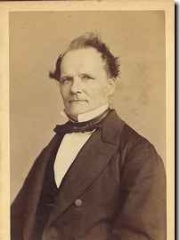
5. Ernst Kummer (1810 - 1893)
With an HPI of 68.68, Ernst Kummer is the 5th most famous Polish Mathematician. His biography has been translated into 41 different languages.
Ernst Eduard Kummer (29 January 1810 – 14 May 1893) was a German mathematician. Skilled in applied mathematics, Kummer trained German army officers in ballistics; afterwards, he taught for 10 years in a gymnasium, the German equivalent of high school, where he inspired the mathematical career of Leopold Kronecker.

6. Felix Hausdorff (1868 - 1942)
With an HPI of 68.33, Felix Hausdorff is the 6th most famous Polish Mathematician. His biography has been translated into 45 different languages.
Felix Hausdorff ( HOWS-dorf, HOWZ-dorf; November 8, 1868 – January 26, 1942) was a German mathematician, pseudonym Paul Mongré (à mon gré (Fr.) = "according to my taste"), who is considered to be one of the founders of modern topology and who contributed significantly to set theory, descriptive set theory, measure theory, and functional analysis. Hausdorff was Jewish, and life became difficult for him and his family after the Kristallnacht of 1938. The next year he initiated efforts to emigrate to the United States, but was unable to make arrangements to receive a research fellowship. On 26 January 1942, Hausdorff, along with his wife and his sister-in-law, died by suicide by taking an overdose of veronal, rather than comply with German orders to move to a concentration camp in Endenich.

7. Ehrenfried Walther von Tschirnhaus (1651 - 1708)
With an HPI of 68.24, Ehrenfried Walther von Tschirnhaus is the 7th most famous Polish Mathematician. His biography has been translated into 30 different languages.
Ehrenfried Walther von Tschirnhaus or Tschirnhauß (German: [ˈeːʁənfʁiːt ˈvaltɐ fɔn ˈtʃɪʁnhaʊs]; 10 April 1651 – 11 October 1708) was a German mathematician, physicist, physician, and philosopher. He introduced the Tschirnhaus transformation and is considered by some to have been the inventor of European porcelain, an invention long accredited to Johann Friedrich Böttger, while others claim porcelain had been made by English manufacturers at an even earlier date.

8. Wacław Sierpiński (1882 - 1969)
With an HPI of 67.70, Wacław Sierpiński is the 8th most famous Polish Mathematician. His biography has been translated into 37 different languages.
Wacław Franciszek Sierpiński (Polish: [ˈvat͡swaf fraɲˈt͡ɕiʂɛk ɕɛrˈpij̃skʲi] ; 14 March 1882 – 21 October 1969) was a Polish mathematician. He was known for contributions to set theory (research on the axiom of choice and the continuum hypothesis), number theory, theory of functions, and topology. He published over 700 papers and 50 books. Three well-known fractals are named after him (the Sierpiński triangle, the Sierpiński carpet, and the Sierpiński curve), as are Sierpiński numbers and the associated Sierpiński problem.

9. Charles Proteus Steinmetz (1865 - 1923)
With an HPI of 67.44, Charles Proteus Steinmetz is the 9th most famous Polish Mathematician. His biography has been translated into 29 different languages.
Charles Proteus Steinmetz (born Karl August Rudolph Steinmetz; April 9, 1865 – October 26, 1923) was a Prussian-American mathematician and electrical engineer and professor at Union College. He fostered the development of alternating current that made possible the expansion of the electric power industry in the United States, formulating mathematical theories for engineers. He made ground-breaking discoveries in the understanding of hysteresis that enabled engineers to design better electromagnetic apparatus equipment, especially electric motors for use in industry. At the time of his death, Steinmetz held over 200 patents. A genius in both mathematics and electronics, he did work that earned him the nicknames "Forger of Thunderbolts" and "The Wizard of Schenectady". Steinmetz's equation, Steinmetz solids, Steinmetz curves, and Steinmetz equivalent circuit are all named after him, as are numerous honors and scholarships, including the IEEE Charles Proteus Steinmetz Award, one of the highest technical recognitions given by the Institute of Electrical and Electronics Engineers professional society.
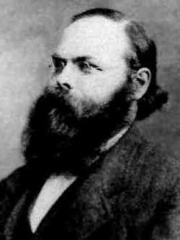
10. Hermann Schwarz (1843 - 1921)
With an HPI of 67.00, Hermann Schwarz is the 10th most famous Polish Mathematician. His biography has been translated into 33 different languages.
Karl Hermann Amandus Schwarz (German: [ˈhɛʁman ˈʃvaʁts]; 25 January 1843 – 30 November 1921) was a German mathematician, known for his work in complex analysis.
People
Pantheon has 45 people classified as Polish mathematicians born between 1230 and 1947. Of these 45, 3 (6.67%) of them are still alive today. The most famous living Polish mathematicians include Michael O. Rabin, Henryk Iwaniec, and Krystyna Kuperberg. The most famous deceased Polish mathematicians include Benoit Mandelbrot, Stefan Banach, and Leopold Kronecker.
Living Polish Mathematicians
Go to all RankingsMichael O. Rabin
1931 - Present
HPI: 61.03
Henryk Iwaniec
1947 - Present
HPI: 52.91
Krystyna Kuperberg
1944 - Present
HPI: 51.19
Deceased Polish Mathematicians
Go to all RankingsBenoit Mandelbrot
1924 - 2010
HPI: 73.71
Stefan Banach
1892 - 1945
HPI: 73.02
Leopold Kronecker
1823 - 1891
HPI: 72.71
Marian Rejewski
1905 - 1980
HPI: 68.93
Ernst Kummer
1810 - 1893
HPI: 68.68
Felix Hausdorff
1868 - 1942
HPI: 68.33
Ehrenfried Walther von Tschirnhaus
1651 - 1708
HPI: 68.24
Wacław Sierpiński
1882 - 1969
HPI: 67.70
Charles Proteus Steinmetz
1865 - 1923
HPI: 67.44
Hermann Schwarz
1843 - 1921
HPI: 67.00
Martin Kutta
1867 - 1944
HPI: 66.88
Hermann Grassmann
1809 - 1877
HPI: 66.71
Overlapping Lives
Which Mathematicians were alive at the same time? This visualization shows the lifespans of the 25 most globally memorable Mathematicians since 1700.

